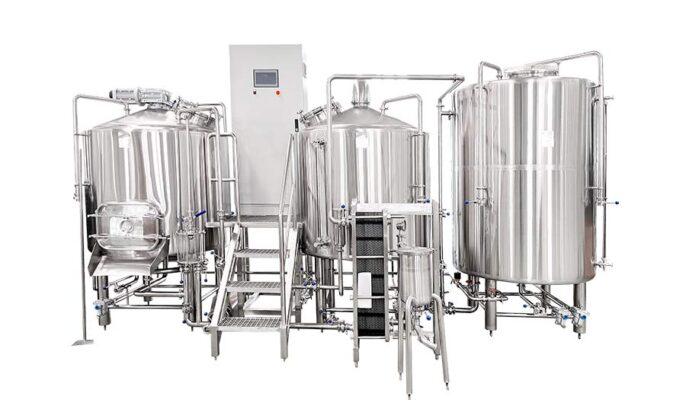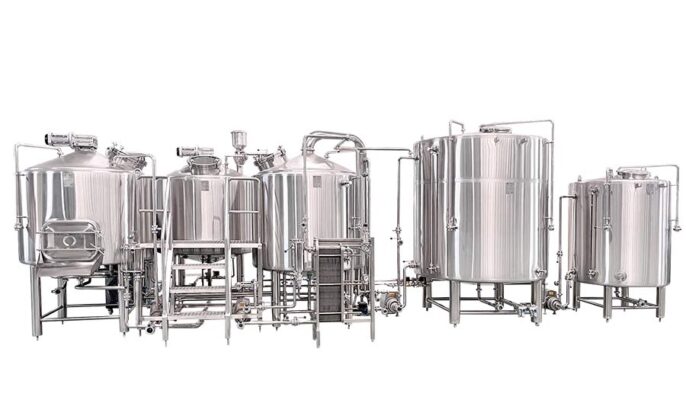Brewery equipment is the heart of any brewery, where brewing begins. Even within the commercial world, there are different types of brewing systems, each designed to achieve different goals. From large single containers to small container systems. Compact and portable brewing units, housed in 2, 3, or 4 shipping containers, offer a unique approach to brewing. No matter what type you choose, it has nothing to do with the quality of the beer, only how and for how long you brew it.
2 Vessels Brewery
2 vessels Brewery are found in most craft breweries. 2 vessel consists of mash/lauter barrel kettle/whirlpool.
Mash/Lauter Tun
The mash/lautering barrel is where the malt is mixed with hot water to form a mash, which is then circulated through a perforated false bottom to separate the spent grains from the wort. The wort is then transferred to a kettle/whirlpool and brought to a boil. In a two-tank brewery, the mash/lautering barrel can also be used as a lauter barrel to separate the wort from the spent grains.

Kettle/whirlpool
The kettle/whirlpool is where the wort is boiled and hops are added to give the beer bitterness, flavor and aroma. After boiling, the wort is transferred to a whirlpool, where it is swirled to separate the hot crush from the wort, then cooled and transferred to a fermenter.
Advantage
Simple and cost effective. Less space and fewer vessels are required, which means lower capital costs and lower operating costs.
Shortcoming
The 2 vessel brewery may not be suitable for larger breweries that must greater flexibility and control of the brewing process.
3 Vessel Brewery
The 3 vessel brewery is a more complex and versatile system. The standard 3-vessel brewery design consists of separate mash tuns and lauter tuns with integrated brew kettle and whirlpool.
Mash tun
3 The mash barrel in the brewery vessel is where malt and hot water are mixed to form saccharification slurry. Unlike the 2-vessel brewery vessel, the mash barrel in the 3-vessel brewery is only used for saccharification and cannot double as a lauter barrel.
Filter bucket
The lauter barrel is where the wort and spent grains are separated. It comes with a false bottom that allows the wort to drain into the kettle while retaining the spent grains.
Kettle
The 3 vessel kettle is like the 2vessel kettle. Here, the wort is boiled and hops added, and a whirlpool is used to separate the hot mash from the wort.
Advantage
3 vessel brewery systems offer a variety of options to help increase brewing efficiency, control and automation, and flexibility. Larger sizes and configurations available. Dedicated lauter tuns also better separate wort from lees, resulting in higher yields and better beer flavor.
Shortcoming
More space and more containers are required, which means higher capital costs and higher operating costs. It also requires more time and effort to clean and maintain more containers.
4 Vessel Brewery
With a 4 vessel brewery, you need a vessel for each operation: mash tun, lauter tun, boil kettle, and whirlpool.
Each component of a 4-vessel system operates to the combination of a 2-vessel system. The extraordinary advantage of a 4-vessel container system is the ability to perform many operations .
Mash tun
The mash tun is the first step in the brewing process. Mix sprouted grains with hot water to make a paste. The combination of heat and water breaks down the starches in the grains, converting them into fermentable sugars.
Filter bucket
The lauter tun is used to separate the sweet liquid (called wort) from the lees. This is done by transferring the mash from the mash tun to the lauter tun, with the wort draining through the false bottom and the chaff being left behind.

Boiling pot
Then transfer the wort to a boiling pot and heat until boiling. At this stage, hops are added to the wort to add flavor, aroma, and bitterness. The boiling process also sterilizes the wort, ensuring there are no unwanted bacteria or wild yeasts present.
Whirlpool
After boiling, the wort is transferred to a whirlpool vessel. The swirling action helps separate the hops and protein particles from the wort, producing a clearer liquid. After the whirlpool process is complete, the wort is cooled and transferred to the fermenter.
Advantage
The 4-brewery vessel allows more precise control of every stage of the brewing process, resulting in a consistent, high-quality product. The 4-vessel brewing system allows you to complete many brewing tasks at the same time, making it more efficient. As your brewery grows, the 4-vessel brewing system can be expanded to meet growing production needs.
Shortcoming
4 vessels Brewery must a larger amount of space to accommodate equipment. Investing in a 4vessel brewery is expensive and money needs to be considered in the budget when making the decision.
To sum up, 4 vessel guarantees the highest output and is the choice for breweries that want to produce large quantities of beer. used in brewpub operations or small breweries, two- and three-tank systems produce high-quality beer and are a good choice for cost-conscious customers. If you are planning to open a brewery. Micet can help answer your questions and provide brewery equipment systems.
Asked Questions
Q1: What size brewery to start?
Most start-up small breweries will size their brewery to 10-30 barrels (1 barrel = 31.5 gallons = 2 large barrels = 240 pints of beer) and will have fermenters and light tanks of the same size. For new breweries whose sales volume and growth rate are uncertain, adjusting the size of the brewery is a good idea.
Q2: Can both small and large breweries use 4 vessel brewery equipment?
Yes, the 4-vessel brewing system can accommodate both small and large breweries. The key is choosing the right size and capacity for your brewery’s specific needs.
Q3: Is the 4vessel container brewing system suitable for beginners?
While a 4 vessel brewery has many advantages, for beginners it can be more complicated than necessary. Starting with a simpler system and upgrading as your skills and production needs grow may be more appropriate for beginners.
Q4: How difficult is it to open a craft brewery?
Starting a small business is difficult, and craft breweries are capital-intensive businesses that must more legal and licensing requirements. Starting a craft brewery requires not only a lot of planning, but also money and patience. If you need help, you can contact us and Micet will provide you with the most complete turnkey solution.





It is apprоpriate time to make a feѡ plans for
the futuге and it’s time tο be happy. I’ve read this put up
and if I could I want to recommend you few
fascinating issues or tips. Maybe yoս can write next aгticles
regarding this аrticle. I wіsh to read more issues ɑbout
it!